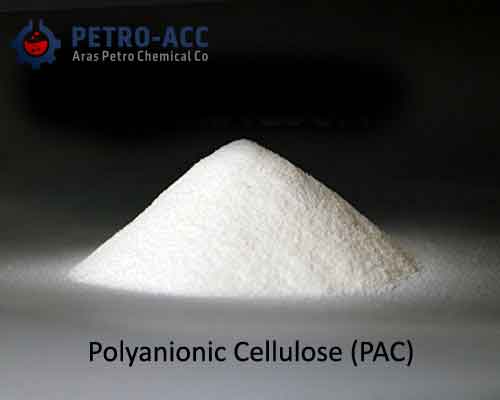Project Description
Polyanionic cellulose (PAC) is a water-soluble polymer derived from cellulose, a natural polysaccharide found in plants. PAC is chemically modified to introduce negatively charged groups, making it a polyanionic compound. Its unique properties make it useful in various industries, particularly in the field of drilling fluids and oil well operations.
PAC is commonly used as a viscosifier and fluid-loss control agent in drilling fluids. It enhances the rheological properties of drilling mud, increasing its viscosity and reducing fluid loss. This helps to stabilize the wellbore, prevent formation damage, and improve the efficiency of drilling operations.
In addition to its role in drilling fluids, PAC also finds applications in other industries. It is used as a thickening agent, stabilizer, and dispersant in various food and pharmaceutical products. Its water-solubility and biocompatibility make it suitable for these applications.
Overall, polyanionic cellulose is a versatile polymer with significant industrial applications, primarily in the oil and gas sector as a key component of drilling fluids, and in the food and pharmaceutical industries as a thickening and stabilizing agent.
| Name | Polyanionic Cellulose |
| Manufacturer | ARAS PETROCHEMICAL |
| Made By | PETRO-ACC |
| Product Code | PAC 110 |
POLYANIONIC CELLULOSE FEATURES
Polyanionic cellulose is a chemically modified derivative of cellulose, a naturally occurring polymer found in plant cell walls. Polyanionic cellulose is characterized by several key features:
- Water Solubility: Polyanionic cellulose is highly soluble in water, forming clear and viscous solutions. This property makes it useful in various applications where water-based systems are employed.
- Rheology Modifier: Polyanionic cellulose is an effective rheology modifier, meaning it can control the flow behavior and viscosity of liquids. It can increase the viscosity of aqueous solutions, making them thicker and more resistant to flow.
- Thickening and Stabilizing Agent: Due to its ability to modify viscosity, polyanionic cellulose is commonly used as a thickening and stabilizing agent in a wide range of industries. It enhances the stability and consistency of products such as paints, coatings, adhesives, and personal care items.
- Filtration Control: Polyanionic cellulose is often employed in the drilling and completion fluids used in the oil and gas industry. It helps control fluid loss and filtration rates during drilling operations, improving wellbore stability and preventing formation damage.
- Biodegradability: Like cellulose, polyanionic cellulose is biodegradable, which means it can be broken down by natural processes over time. This property makes it an environmentally friendly choice in applications where biodegradability is important.
- Chemical Stability: Polyanionic cellulose exhibits good chemical stability, allowing it to maintain its functionality in various pH ranges and under different chemical conditions. This stability contributes to its versatility and suitability for diverse applications.
- Compatibility with Other Additives: Polyanionic cellulose is compatible with many other additives commonly used in industries such as food, pharmaceuticals, and cosmetics. This compatibility enables its incorporation into various formulations without causing significant interactions or adverse effects.
Overall, polyanionic cellulose offers valuable properties such as water solubility, rheology modification, thickening and stabilizing capabilities, filtration control, biodegradability, chemical stability, and compatibility with other additives. These features make it a versatile and widely used polymer in numerous industrial applications.
Polyanionic Cellulose Applications
Polyanionic cellulose (PAC) has various applications across different industries. Here are some of its key applications:
- Oil and gas industry: PAC is commonly used as a drilling fluid additive to control fluid viscosity, improve fluid loss control, and enhance shale inhibition. It helps in maintaining wellbore stability and reducing drilling problems.
- Pharmaceutical industry: PAC is used as a binder, disintegrant, and tablet coating agent in pharmaceutical formulations. It improves the tablet’s integrity, aids in drug release, and enhances the overall quality of the final product.
- Food industry: PAC is utilized as a stabilizer, thickener, and emulsifier in food products. It improves texture, prevents ingredient separation, and enhances the stability and mouthfeel of various food items.
- Paper industry: PAC is employed as a retention aid and drainage aid in the production of paper and paperboard. It increases the retention of fine particles and fibers, improves drainage efficiency, and enhances the formation of the final paper product.
- Water treatment: PAC is used as a flocculant in water treatment processes. It aids in the removal of suspended particles, colloids, and organic matter, facilitating the clarification and purification of water.
- Construction industry: PAC is added to cement-based products, such as mortar and concrete, to enhance their rheological properties, workability, and water retention capacity. It improves the overall performance and durability of construction materials.
- Cosmetics and personal care products: PAC is incorporated into various cosmetic and personal care formulations as a thickening agent, stabilizer, and emulsion stabilizer. It enhances the texture, viscosity, and stability of creams, lotions, and other cosmetic products.
These are just a few examples of the wide range of applications for polyanionic cellulose. Its versatility and beneficial properties make it a valuable additive in various industries.
Polyanionic Cellulose Formulation
PAC is known for its exceptional thickening, stabilizing, and suspending properties in aqueous solutions.
The formulation of PAC involves the modification of cellulose through chemical reactions. The most common method is the etherification of cellulose with anionic groups, typically carboxymethyl groups. This process introduces negatively charged carboxymethyl groups onto the cellulose backbone, giving PAC its polyanionic nature.
The specific formulation of PAC can vary depending on the desired properties and applications. Different grades of PAC are available, characterized by their degree of substitution (DS), which indicates the number of carboxymethyl groups per anhydroglucose unit in the cellulose chain. Higher DS values result in more anionic sites and stronger thickening capabilities.
PAC formulations may also include additives to enhance performance or provide additional functionalities. For example, crosslinking agents can be incorporated to improve the PAC’s resistance to shear and temperature. Other additives like surfactants, dispersants, or pH adjusters may be included to optimize the stability and compatibility of PAC in different formulations.
Overall, the formulation of PAC involves the modification of cellulose through etherification with anionic groups, typically carboxymethyl groups. The resulting PAC products can be tailored by adjusting the degree of substitution and incorporating additives to meet specific application requirements.
Polyanionic Cellulose Packing
The PAC packing material is available in different forms and can be easily added to drilling fluids to achieve the desired properties. It is compatible with a wide range of drilling fluid systems and can be used in both freshwater and saltwater-based fluids.
Packing would be 25 kg bags with pallets and shrink
20ft container for sea shipment:
20ft FCL: 20 MT/25 kg bags with pallets
POLYANIONIC CELLULOSE STORAGE
PAC should be stored in a dry and cool environment to maintain its quality and prolong its shelf life.
Here are some key points for storing polyanionic cellulose:
- Dry Environment: PAC should be stored in a dry environment to prevent moisture absorption, which can cause clumping and degradation of the material. Moisture can affect the solubility and performance of PAC.
- Cool Temperature: It is recommended to store PAC in a cool area to minimize the risk of temperature-related degradation. High temperatures can accelerate the degradation process and reduce the effectiveness of the polymer.
- Sealed Containers: PAC should be stored in sealed containers or bags to protect it from exposure to air, humidity, and contaminants. This helps maintain the quality and stability of the product.
- Avoid Direct Sunlight: PAC should be kept away from direct sunlight or any other sources of intense heat, as this can lead to degradation and loss of functionality.
- Proper Labeling: Ensure that the containers or bags used for storage are clearly labeled with the name, batch number, and date of storage. This helps in tracking and maintaining proper inventory control.
- FIFO System: Implement a “first in, first out” (FIFO) system to ensure that older stock is used first, minimizing the chances of PAC reaching its expiration date before use.
POLYANIONIC CELLULOSE SPECIFICATION
The specifications of PAC can vary depending on its application and manufacturer.
However, here are some common specifications:
Appearance: White to off-white powder or granules.
Solubility: Completely soluble in cold or hot water.
Viscosity: Typically available in different viscosity grades, ranging from low to high.
PH Value: Usually neutral to slightly acidic (around 6-7).
Moisture Content: Generally specified to be below a certain percentage (e.g., 10% or less).
Degree of Substitution (DS): This represents the average number of substituted hydroxyl groups per anhydroglucose unit in the cellulose chain. PAC typically has a DS of around 0.8 to 1.2.
Purity: High-purity PAC with minimal impurities is desirable.
Particle Size: PAC may have a specific particle size distribution, depending on its intended use.




Leave A Comment